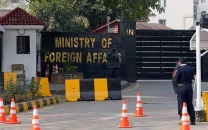A meeting in Thimpu

A meeting in Thimpu
However, as it has been many times in the past, the two countries have been at this precise juncture before, most notably at Sharm el-Sheikh in Egypt in July 2009. For this meeting to mean anything (it did run almost 75 minutes), it must result in a commitment between the two parties to resume the comprehensive dialogue process begun in 2004.
The Indian foreign secretary described the meeting as “very good” but that India’s willingness to “resolve all outstanding issues through dialogue” was hampered by lack of “progress on the issue of terrorism”. Prime Minister Manmohan Singh seems to be personally inclined towards dialogue, but was held back by residual (and legitimate) anger in India over the Mumbai attacks of late 2008.
While it is highly unlikely that anybody in the current civilian administration bears any responsibility for the attack, the Indian public tends to view Pakistan as a monolith and their sentiments towards the country are defined by the actions of whichever few Pakistanis manage to impact their lives.
Having said that, Islamabad should expedite the cases against the Laskhar-e-Taiba men that it has arrested and this should not depend on India sending its own officials to provide statements. That will only delay the case further and provide hawks in India – and Pakistan – yet more cannon fodder.
There seems to be a broad consensus across the Pakistani political spectrum over normalisation of ties with India, so Prime Minister Yousaf Gilani does not face the same reticent public and quarrelsome coalition partners on this issue.
Yet, Mr Singh also carries more political capital. His re-election as prime minister is largely viewed as a vote of trust by the Indian public in the capabilities of his administration. If any Indian politician can afford to take risks, he can. For the sake of the people of South Asia, let us hope that he does.



















COMMENTS
Comments are moderated and generally will be posted if they are on-topic and not abusive.
For more information, please see our Comments FAQ